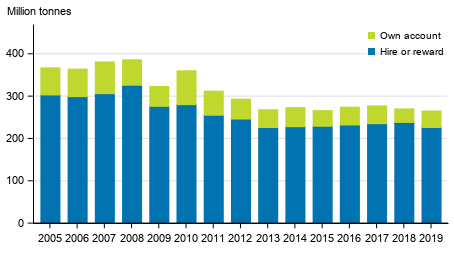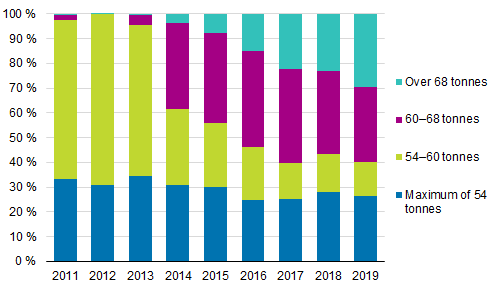Published: 28 April 2020
Slightly fewer goods were transported by lorries in 2019 than in the previous year
Measured by tonnes, one per cent fewer goods were transported by lorries in domestic and international transport in 2019 than in the previous year. In turn, the transport performance grew by two per cent. These data derive from the statistics on goods transport by road compiled by Statistics Finland.
Domestic transport
In 2019, lorries transported altogether 266 million tonnes of goods in domestic transport, which was nearly two per cent lower than one year before. The total length of transport journeys driven was 1.9 billion kilometres, which was the same as in 2018. The transport performance totalled close on 27 million tonne-kilometres, which was almost three per cent more than in 2018. Tonne-kilometre describes the volume of transport and is obtained as a product of the transported volume of goods given in tonnes and the length of the transport journey in kilometres.
Annual volume of goods transported by lorries in domestic transport

Professional or licensed transport accounted for 85 per cent of all tonnes of goods transported and for 94 per cent of the transport performance. The share of licensed transport decreased slightly for both performances compared to 2018.
Volume of goods transported by full trailer combinations decreased slightly
Examined by type of lorry, the volume of goods transported by lorries without trailer was around seven per cent lower in 2019 than in the year before, while seven per cent more goods were transported by semi-trailer combinations than in 2018. The transport performance for lorries without trailer increased by 14 per cent and for semi-trailer combinations it decreased by two per cent. In turn, the volume of goods transported by full trailer combinations fell by one per cent and the transport performance grew by three per cent compared to the year before.
The use of full trailer combinations in goods transport grew between 2014 and 2016. The growth evened out in 2017 and the slight downward trend continued in 2018. Fifty-six per cent of goods and 75 per cent of tonne-kilometres were transported with full trailer combinations in 2018, while the corresponding share was 57 per cent of tonnes and 74 per cent of tonne-kilometres in 2019.
The relative share of lorries without trailer in goods transport has decreased considerably in the 2010s. However, the share of the volume of transported goods grew by two percentage points in 2018. In 2019, the share decreased by two percentage points back to the level of 2017. The use of semi-trailer combinations relative to other types of vehicles has remained more or less the same since 2011.
Over one-quarter of the annual volume of goods are transported by combinations with a total weight of over 68 tonnes
In 2019, lorries with a total weight of over 68 tonnes transported 72 million tonnes of goods, which was 27 per cent of the total volume of goods transported. The share has increased steadily as a result of the decree on the use of vehicles that entered into force at the end of 2013 regarding the mass and measurements of vehicle combinations.
When lorries are grouped according to the highest permitted total weight into lorries weighing at most 54, over 54 to 60, over 60 to 68 and over 68 tonnes, the groups’ shares of the transported volume of goods were 45, 9, 19 and 27 per cent and of the transport performance 27, 14, 30 and 30 per cent in 2019. The shares of the total weight categories of the transport performance in 2011 to 2019 are presented in the figure below.
The development of the transport performance by total weight categories in 2011 to 2019

Examined by types of goods, gravel and other soil materials were transported most by road in 2019, in total 90 million tonnes, which was good one-third of all tonnes. Most transport performance was generated from transport of saw timber and pulpwood, three billion tonne-kilometres or 13 per cent of all tonne-kilometres.
The average transport journey was 79 kilometres in 2019, which was two kilometres more than one year earlier. The average transport journey was 36 kilometres for soil materials and 98 kilometres for saw timber and pulpwood. The average length of empty journeys was 45 kilometres, which was on the same level as the years before.
International transport
In 2019, lorries transported a total of 4.5 million tonnes of goods in international transport, which was close on one quarter more than one year before. The transport performance in international transport totalled 2.1 billion tonne-kilometres, which was 13 per cent less than in the previous year.
It should be noted that the statistics on goods transport by road always monitor the transport performance of a truck tractor selected to the survey during the survey period. The truck tractor selected to the sample may have several different trailers during the survey period. Therefore, if trailers are hauled to a harbour from which they continue in sea transport without the truck tractor, the monitoring of the transport ends there.
Source: Goods Transport by Road 2019, Statistics Finland
Inquiries: Sofia Pitkänen 029 551 3037, liikenne.matkailu@stat.fi
Director in charge: Mari Ylä-Jarkko
Publication in pdf-format (179.7 kB)
- Tables
-
Tables in databases
Pick the data you need into tables, view the data as graphs, or download the data for your use.
Updated 28.4.2019
Official Statistics of Finland (OSF):
Goods transport by road [e-publication].
ISSN=2342-3617. 2019. Helsinki: Statistics Finland [referred: 26.12.2025].
Access method: http://stat.fi/til/kttav/2019/kttav_2019_2020-04-28_tie_001_en.html

